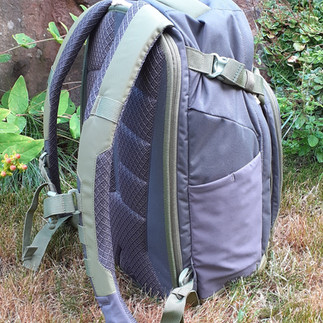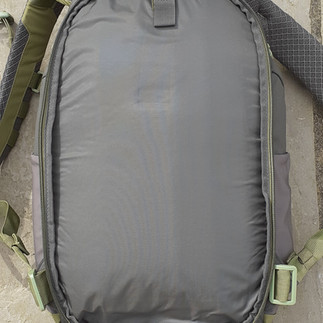
History of 5.11

5.11 is an American company founded 30 years ago. It's a name synonymous with clothing and providing equipment for armed forces, law enforcement and civilian shooters, hikers and survivalists across the globe. 5.11 has a great reputation providing kit and equipment that's reasonably priced, whilst always evolving existing lines to improve their resilience for their users.
For more info - visit 5.11 website.
Why the 5.11 COVRT18 2.0 Backpack?
The 5.11 COVRT18 2.0 backpack was chosen for two reasons. Number 1, I needed a large enough backpack that could carry a large amount of bulky kit whether it be medical, communications, ancillary range equipment or a bug out kit, with the ability to compress contents and yet provide enough pockets / storage areas in which kit could be safely and securely stowed. Number 2, the backpack needed to be free of the typical military tells such as MOLLE / PALS webbing, external logos and generally not appear to be a military'esque backpack. I've previously reviewed the AVS 1000 Pack which was ideal for lightweight fight and flight, but the COVRT18 enabled me to increase carriage of equipment. For use in a civilian or low profile role the COVRT18 ticked all of the boxes and having researched a number of backpacks that could suit me, I took the plunge and obtained the COVRT18.
Product details
Herein lies the product description from the website;
Description
Although it offers the versatility of a tactical pack, the COVRT18 2.0 is the next iteration in a serious of backpacks designed not to call a lot of attention to itself. Whether you’re working in austere environments or just want a pack with a street-smart look, we’ve thought about the areas you’ve requested a more discreet appearance and made the necessary improvements. On the outside you’ll find contemporary features like dual water bottle pockets and a shove-it pocket, but we’ve also included tuckable logos, a TSA friendly laptop compartment, and a front pocket with removable ID panels and slip pockets to tone down your profile. A flex cuff channel, zippered drop pocket, and dual-access CCW compartment give the COVRT18 2.0 another level of hidden gems you’ll surely appreciate in certain environments.
Features
5.11's signature Center Line design
500D Nylon | 840D Nylon
Hydration or TSA checkpoint friendly laptop rear compartment
Front pocket with removable ID panel, slip pockets, web MOLLE and loop
Shove-It compartment with side gussets and zippered drop pocket
Dual side water bottle pockets
Dual access CCW compartment with internal loop panel
Internal zippered mesh pockets in main compartment
External Hypalon gear loop
Flex cuff channel
Tuckable 5.11 logo woven labels
Dimensions
19”H x 10.5”L x 6.5”D
32-liter / 1953 cubic inch
Weight - 2.64 LBS
Fits up to a 15" laptop
Packaging exterior
The 5.11 COVRT18 2.0 Backpack was shipped in a standard large clear plastic sealable bag. The exterior of the bag featured one product sticker. The entire package in total weighed 1.25kgs.
Contents
The 5.11 COVRT18 2.0 Backpack package contained only the backpack itself.
Components in detail
The 5.11 COVRT18 2.0 Backpack is manufactured using a mixture of 500D and 840D Nylon, plastic zip tags, paracord and metal zips. The base fabric used throughout the COVRT18 is as mentioned Nylon, whilst the stretch panels are a mixture of Nylon and Spandex.

COVRT18 Pack Measurements
Height 48 cm
Width 32 cm
Depth 9.5 cm (empty)
The COVRT18 weighs 1.2kgs
Front panel
The COVRT18 from the exterior has numerous accessible pockets of varying sizes which are covered in detail below.
Of note is that on the front bottom of the exterior pocket is a small 5.11 tag which is concealable by pushing inside a sleeve behind it to further hide that this is a tactical pack. The only other tag denoting it's 5.11 is on the right hand side shoulder strap which again can be part concealed by tucking into a small hidden sleeve.
The first pocket with a double zip (57 cm across) is a good medium sized pocket as highlighted in red in image one below. Once opened up fully and the front is folded down, the interior of the pocket can be split into three. The main pocket itself measures approx 31 x 23 cm (H x W) and can fit a good amount of kit in it. At the forefront of the pocket is a row of 6x3 PALS loops, 8 of which have velcro loop panels attached. This enables the user to attach any MOLLE pouches such as a tearaway med kit or singular m4 magazine pouch to the pocket. The pack came with a small black removable ID panel (not included in photographs) that could be used to cover any unit patches that are attached on the velcro. The pocket also features at the rear two identically sized vertical pockets (separated by vertical stitching from top to bottom) which are ideal for pens, leatherman, battery pack etc. At the top of the pocket on the left hand side is also a stitched in hook clip which is useful for attaching anything such as a compass or other item to it preventing it from falling out of the pocket if opened accidentally.
The second pocket (image 3 & 6) behind the second pocket is the fold out pocket as highlighted in red in image one below. The pocket is held closed by the buckles on the left and right hand side which keep the front 2 pockets held securely in place. Once unclipped, the pocket opens to approx 45° and is a medium size of 34 x 20 cm (H x W). This pocket has been designed to be a 'stuff pocket' i.e. where a wet jacket, helmet or other kit needing to be accessed quickly without any zip etc can be stored. There is no zip or closure mechanism on this pocket only when the clips are done up does the pocket get partly sealed.
The third pocket (image 1 & 4) is at the top front of the pack with a single small zip (21 cm across) that once opened allows access to a small horizontal interior pocket in the front flap running from left to right. This pocket is highlighted in red in image one below. This pocket measures approx 13 x 20 cm (H x W). The pocket itself is small and is typically designed to hold headtorch, phone, small battery pack, sunglasses etc. The pocket does not feature any drainage holes.
The fourth pocket is almost nearly hidden behind the fold out pocket as highlighted in red in image one below. It features a horizontal zip on both the left and right hand side (xxx cm long). The pocket is large and able to fit a variety of equipment 45 x 22 cm (H x W), however this pocket is marked as a CCW (Concealed Carry Weapon) pocket, whereby the interior is designed to house a handgun either loosely or affixed to the large 13 x 20 (H x W) cm velcro loop panel attached to the rear of the pocket. The main feature of this pocket is that it is accessible from the left or the right hand side and you are able to put your arm al of the way through the pocket as highlighted in orange in images one, two and three below.
Main pocket
The largest main pocket can be accessed by the double zip that runs from the left to the right hand side with an opening of approx 93 cm. The interior of the largest pocket measures 46 x 29 x 14 cm (H x W x D). This pocket space is large and able to accommodate a large variety of potentially bulky equipment. The back interior of the pocket is void of anything. The interior of the front flap features two horizontal mesh zip pockets as seen in image three below. The top pocket measures 13 x 28 cm (H x W) and the bottom pocket measures 14 x 28 cm (H x W). These are designed to house anything that may need to be accessed quickly and the mesh enables the operator to identify what's in those pockets quickly due to the mesh.
Left and right hand side pockets
The left and right hand side pockets are identical. They can store either water bottles, spare magazines or radio equipment if required. The pocket is manufactured using spandex material and the top of the pouch features an elasticated band enabling the pocket to fit snugly around items inserted into the pocket.
The pockets are identical and measure 20 x 12 cm (H x W).
As seen in the above images, the side pockets easily accommodate the Pathfinder Stainless Steel Bottle & Cup (review inbound) and the TRI AN/PRC-148 (UV) MBITR which I previously reviewed.
Rear panel
The rear features two sections which are accessible via the 108 cm double zip running from the left to right hand side. This is described as a 'Hydration or TSA checkpoint friendly laptop rear compartment'. The exterior of the panel itself features two vertical padded supports which are designed to cushion around the operators spine and provide enough cushioning if the pack is heavily loaded. The design of the pad material ensures that it maximises airflow through the hollowcore fibres to help keep the operators back cool. At the bottom exterior on the left and right hand side are some hip belt attachment points. These enable the operator to add a hip belt adding more stability to the pack as an extra securing point. The hip belt is an added extra that does not come included with the pack.
The front interior of the pocket features only a 10 cm velcro loop at the top. This loop is designed for use in conjunction with a hydration bladder which can be attached / hung from the loop preventing sagging when the bladder gets emptier. This area measures 46 H x 28 W cm. The below images show the bladder attached with the tube having to emerge from the top of the rear compartment.
The rear of the pocket additionally features a laptop sleeve measuring 9 x 2.5 (H x W) cm that can accommodate a 15" laptop. It also features a velcro strap that ensures the laptop won't fall out if the rear panel is opened. This laptop pocket measures 35 x 25 cm (H x W).
Top
The top of the pack features a centrally located wide soft grab handle that is stitched into the interior of the pack. This handle measures 17 x 4.8 cm (L x W).
Maintenance
As with all clothing and tactical equipment, maintenance should be a part of the routine of handling, using and storing your gear. Gear that is cleaned, repaired and looked after will last longer which is essential when considering replacement costs of damaged gear through negligence. The pack from the exterior is easy to clean. Recommendations are;
Warm water with a mild detergent and use a soft brush used to remove excess dirt / dust etc from pack.
Stiffer brush can be used on more stubborn debris.
Allow to hang and dry naturally.
Once dry, check pack interior and exterior thoroughly for any rips or damage to threads, zips, straps or seams.
Testing
The COVRT18 was tested in several environments; range, urban woodland over several days. It performed as expected with minimal fuss or issues. I used the pack on the range for carriage of range equipment, on the moors for an extended hike and for several days in a city environment.
Range - the pack carried all my standard range safety equipment and it provided enough space for my bump or ballistic helmet when packed away. The multitude of pockets did take some getting used to i.e. remembering where everything was stowed, but there were certainly enough options.
Hiking - I loaded the pack with 10.5kg of equipment to see how it handled the weight and whilst I wouldn't ever use this pack for an extended overnight stay, 10.5kg did feel about right for the weight in the pack. The shoulder straps are certainly not designed the same way as a traditional bergan and are likely to cut into shoulders and back over time. The easy access hydration bladder pocket and external pockets that contained maps, compass, firelighting equipment etc were all within easy grasp.
City tour - loaded with minimal kit for an excursion in the city it was certainly more than adequate to carry around a laptop, several books, rain jacket and other essential items. It's low profile exterior definitely was an advantage as it didn't stand too far out from other traditional packs around.
Thoughts and opinion
The COVRT 18 Pack is one of those 'tardis like' packs that can house a large amount of gear in it. The number of pockets, access options and stow points means that you're likely able to fit everything you need in this pack easily, depending on if you're needing to carry medical trauma kit, using it in a EDC (Every Day Carry) role or packed with essentials and used as a Bug Out Bag. The sleek low profile exterior and dull colours don't betray it as being a 'tactical' pack at all and typically it does fit in amongst standard civilian packs on the market.
Having used it for carrying kit to and from the range, then to a couple of events with electronic kit and cameras packed away to then wear it for a hike over the moors, it is versatile and rose to the challenge on each occasion. The thick padded straps do take some breaking in to make them more pulpable and the meshed hollowcore fibre padding at the rear does improve circulation.
There are a few design points to be aware of. One thing worth noting with the pack is that to be able to fully access the main pocket without restriction, the two buckles (holding the front pockets / fold out pocket in place) must be undone. Once this is done you can fold the front of the main pocket out, but if it's heavy or has a number of items inside of it it can just flop around which is annoying. It's one design flaw that should really be looked at. Whilst the hydration bladder pocket sits at the rear, when this has a full 2.5l bladder inserted, it does get pressed against the operators back and care does need to be given to ensure that the bladder doesn't pop resulting in a soaked interior of the pack and back. Typically I'd mount / insert the bladder in the main pocket for ease and provide some additional protection from bumps and knocks, a handy slit at the top of the pockets to enable the attachment point to be fed through into the main compartment would be a good update. In addition to this I'd further have a hydration tube slit in the top of the pack next to or under the handle so that the hydration tube doesn't require the existing rear pocket zips to be slightly open. Finally due to the pack being slightly larger than a typical backpack, it can feel bulky / flappy if it's not loaded up fully, so ensure those compression straps are done up tight.
Cards on the table, I am very happy with the 5.11 COVRT18 2.0 Backpack. It is a great pack that meets for me a number of requirements and its versatility and adaptability is what does it for me. If you're after a lower profile pack with plenty of capacity and storage options, I'd say look no further than this one and with a multitude of colours available there will likely be one that fits for you.
Don't forget to check out the HAHO social media platforms below for content, updates and linked articles. Like, Follow, Subscribe and Share!
Final Note
I am not paid for my blogs by the manufacturers or companies that I purchase my items from. I am not offered freebies to promote a product. These blogs are purely written from my own experience in truth to help advise and inform others who may wish to purchase the items or understand more about them. If I am sent a freebie to review this will be stated at the beginning to make you aware.







































































































This is a great review and I appreciate the details you help point out so I know what everything on the bag does. I just bought it today and was looking more into it.
One note, there is a slit for the hydration tube! It's actually in your picture showing the tube coming out of the zipper. It's that stretchy gray fabric right above the tube. You can feed it through the inside of the compartment out that hole. It's tight, so you have to know it's there to find it.
Where is the flex cuff channel?